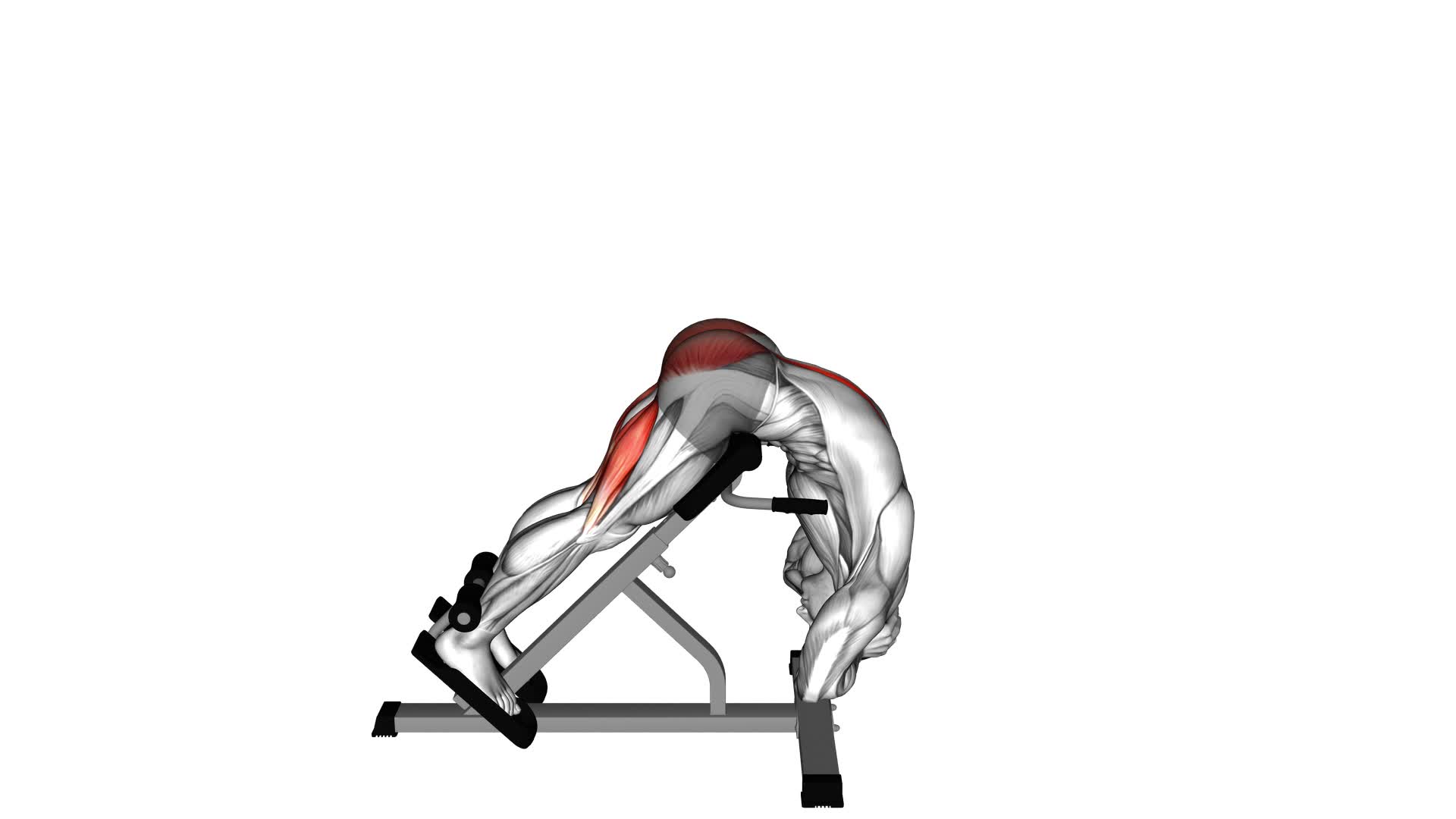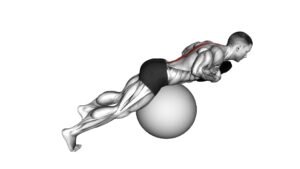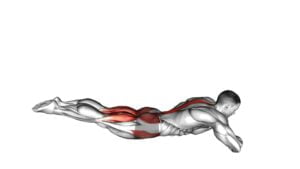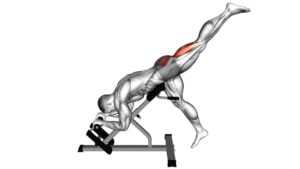Hyperextension – Video Exercise Guide & Tips

Are you looking to amp up your workout routine and target your back muscles? Look no further than hyperextension exercises.
Watch This Exercise Video
In this guide, we'll show you how to perform hyperextensions with proper form and technique, as well as provide variations to keep your routine fresh.
Whether you're a beginner or a seasoned pro, our video exercise guide and tips will help you safely incorporate hyperextensions into your workout for maximum results.
Let's get started!
Key Takeaways
- Hyperextension improves flexibility and range of motion in the spine
- It strengthens the erector spinae muscles for better back support
- Engaging core muscles and using controlled movements is important for proper form and technique
- Optimal alignment and posture, as well as warm-up exercises, are essential for injury prevention during hyperextension exercises.
Benefits of Hyperextension
You should regularly perform hyperextensions because they can provide numerous benefits for your back and core strength.
Hyperextensions are a great exercise to improve flexibility and strengthen your lower back. By incorporating hyperextensions into your workout routine, you can increase the range of motion in your spine and enhance your overall flexibility.
This exercise targets the erector spinae muscles, which run along your spine and play a crucial role in supporting your back. Strengthening these muscles can help alleviate lower back pain and prevent future injuries.
Additionally, hyperextensions engage your glutes, hamstrings, and core muscles, helping to improve your overall stability and balance.
As you perform hyperextensions, focus on maintaining proper form and engaging your core throughout the movement. This will enhance the activation of your abdominal muscles, leading to improved core strength.
Regularly incorporating hyperextensions into your fitness routine can provide significant benefits for your back and core strength, ultimately improving your overall physical performance.
Proper Form and Technique
To perform hyperextension exercises with proper form and technique, there are several key points to keep in mind.
- First, focus on maintaining alignment and posture throughout the movement, keeping your spine neutral and avoiding excessive arching or rounding.
- Second, implement injury prevention techniques such as engaging your core, using controlled and smooth movements, and avoiding jerking or swinging motions.
- Lastly, be aware of common mistakes to avoid, such as hyperextending the lower back or using momentum instead of muscle control.
Alignment and Posture
Maintain optimal alignment and posture to ensure proper form and technique during hyperextension exercises. Proper alignment and posture are essential for improving spinal health and preventing injuries. Here are some key tips to help you achieve the correct alignment and posture:
- Stand tall with your feet hip-width apart.
- Engage your core muscles to support your spine.
- Keep your shoulders relaxed and down, away from your ears.
- Maintain a neutral spine by avoiding excessive arching or rounding.
- Align your head with your spine, keeping it in a neutral position.
By following these guidelines, you can maximize the effectiveness of your hyperextension exercises while minimizing the risk of strain or injury.
Remember to listen to your body and make adjustments as needed to maintain proper alignment and posture throughout your workout.
Injury Prevention Techniques
To ensure injury prevention techniques and maintain proper form and technique during hyperextension exercises, it's important to focus on maintaining optimal alignment and posture.
Proper alignment helps distribute the load evenly and reduces stress on the joints, minimizing the risk of injuries. Keep your head aligned with your spine and avoid arching your lower back excessively. Engage your core muscles throughout the exercise to stabilize your spine and protect it from excessive strain.
Additionally, using muscle activation techniques can help activate the correct muscles and prevent compensatory movements. Before performing hyperextension exercises, warm up your body to increase blood flow to the muscles and improve flexibility.
Remember to start with lighter weights and gradually increase the load as you become more comfortable and confident with the exercise.
Common Mistakes to Avoid
Avoid these common mistakes to ensure proper form and technique while performing hyperextension exercises:
- Not maintaining a neutral spine: Avoid arching or rounding your back during the movement. Keep your spine in a neutral position to protect your lower back.
- Using momentum: Don't rely on momentum to complete the exercise. Instead, focus on controlled and deliberate movements to engage your muscles effectively.
- Neglecting core engagement: Engage your core muscles throughout the exercise to stabilize your spine and protect your lower back.
- Overextending at the top: Avoid hyperextending your spine at the top of the movement. Stop just short of a full extension to maintain proper form.
- Lack of warm-up: Always warm up your body before performing hyperextension exercises to prepare your muscles and reduce the risk of injury.
Variations of Hyperextension Exercises
Now let's explore the different variations of hyperextension exercises and their benefits.
By incorporating these variations into your routine, you can target different muscle groups and enhance overall strength and stability.
Remember to maintain proper form and technique to maximize the effectiveness of each exercise and prevent injuries.
Lastly, be mindful of common mistakes to avoid, such as using momentum or overextending your back, to ensure a safe and efficient workout.
Benefits of Hyperextension
What are the benefits of performing different variations of hyperextension exercises?
Hyperextension exercises offer a range of benefits that can help improve your overall fitness and well-being. Here are some key advantages of incorporating different variations of hyperextension exercises into your workout routine:
- Improving core strength: Hyperextension exercises target the muscles in your lower back, abdominals, and glutes, which are essential for maintaining a strong and stable core.
- Enhancing lower back flexibility: By regularly performing hyperextension exercises, you can increase the flexibility and mobility of your lower back, reducing the risk of injuries and improving your overall range of motion.
- Strengthening posterior chain muscles: Hyperextension exercises engage the muscles in your posterior chain, including your hamstrings, glutes, and erector spinae, helping to build strength and stability in these areas.
- Correcting posture: Hyperextension exercises can help correct poor posture by strengthening the muscles that support your spine and encouraging proper alignment.
- Preventing lower back pain: Regularly incorporating hyperextension exercises into your routine can help alleviate and prevent lower back pain by strengthening and stabilizing the muscles in this area.
By understanding the benefits of different variations of hyperextension exercises, you can make informed decisions about which exercises to include in your workout routine to enhance your core strength and lower back flexibility.
Now, let's move on to the next section, which will focus on proper form and technique to maximize the effectiveness and safety of hyperextension exercises.
Proper Form and Technique
To ensure proper execution and maximize the effectiveness of hyperextension exercises, it's important to focus on maintaining a strong and stable core throughout the various variations.
Proper alignment and posture are essential for preventing injuries and getting the most out of your workout. When performing hyperextensions, start by lying face down on a hyperextension bench with your feet secured. Keep your core engaged and your back straight as you lift your upper body off the bench, using your lower back muscles.
Avoid overarching your back or straining your neck. Remember to breathe steadily and exhale as you lift your upper body.
Common Mistakes to Avoid
To avoid common mistakes in variations of hyperextension exercises, use proper form and technique. It's important to maintain proper alignment throughout the movement to prevent injury and maximize the effectiveness of the exercise.
Here are some alignment tips to help you avoid hyperextension:
- Keep your spine neutral by engaging your core muscles and avoiding excessive arching or rounding of the back.
- Maintain a slight bend in your knees to avoid putting excessive strain on your lower back.
- Avoid lifting your head too high, as this can strain your neck. Instead, keep your gaze down towards the floor.
Control the movement and avoid using momentum.
Slow and controlled repetitions will engage your muscles more effectively.
Listen to your body and stop if you feel any pain or discomfort. It's better to perform the exercise with proper form than to risk injury.
Tips for Beginners
For beginners, it's important to focus on proper form and technique when performing the hyperextension exercise. This exercise can be beneficial for strengthening the lower back, glutes, and hamstrings, but it's crucial to start with the right foundation.
As a beginner, you should begin with beginner exercises that gradually build up your strength and flexibility. Start with a shorter range of motion and gradually increase it as you become more comfortable and confident.
It's also important to engage your core muscles throughout the exercise to provide stability and support to your lower back. Remember to breathe in a controlled manner and avoid holding your breath.
Additionally, it's recommended to start with bodyweight exercises before progressing to using additional weights or resistance. By focusing on proper form, starting with beginner exercises, and gradually increasing your range of motion and intensity, you can safely and effectively perform the hyperextension exercise.
Now, let's move on to the next section, where we'll discuss safety precautions and common mistakes to avoid.
Safety Precautions and Common Mistakes
Be cautious and avoid these common mistakes when performing the hyperextension exercise. Safety precautions and proper alignment are crucial to prevent injuries and maximize the effectiveness of this exercise. Here are some important tips to keep in mind:
- Maintain proper form: Make sure your hips are securely positioned on the hyperextension bench, with your feet firmly planted on the footrests. Keep your back straight and engage your core throughout the movement.
- Start with a manageable weight: Begin with lighter weights or bodyweight until you're comfortable and confident with the exercise. Gradually increase the weight as you become stronger and more experienced.
- Avoid excessive hyperextension: While it's important to extend your back, avoid overextending to the point of discomfort or pain. Focus on controlled movements and stop if you feel any strain in your lower back.
- Use a full range of motion: Lower your upper body until it's parallel to the floor, then slowly raise it back up to the starting position. Avoid shortening the movement or using momentum to complete the exercise.
- Breathe properly: Inhale as you lower your upper body and exhale as you raise it back up. Keeping a steady breathing pattern helps stabilize your core and maintain proper form.
By following these safety precautions and avoiding common mistakes, you can perform the hyperextension exercise safely and effectively.
Now, let's explore how to incorporate hyperextension into your workout routine.
Incorporating Hyperextension Into Your Workout Routine
Now let's explore how you can integrate hyperextension into your workout routine to strengthen your back and improve overall core stability.
Hyperextension exercises can be modified to suit your fitness level and goals. If you're a beginner, start with a basic hyperextension exercise using just your body weight. Lie face down on a hyperextension bench, with your feet secured under the foot pads. Cross your arms over your chest and slowly lift your upper body off the bench, using your lower back muscles. Gradually increase the range of motion as you become more comfortable with the exercise.
For those who are more advanced, there are several techniques you can incorporate into your hyperextension routine. One option is to hold a weight plate against your chest while performing the exercise. This added resistance will challenge your muscles even more.
Another advanced technique is to perform hyperextensions on a stability ball. This requires additional core stability to maintain balance throughout the movement.
Additionally, you can try performing hyperextensions with a twist, where you rotate your torso to one side as you lift your upper body off the bench. This engages your oblique muscles and adds an extra challenge to the exercise.
Remember to always maintain proper form and listen to your body. If you experience any pain or discomfort, stop the exercise and consult with a fitness professional.
Frequently Asked Questions
How Many Sets and Repetitions Should I Do for Hyperextension Exercises?
For hyperextension exercises, it's important to determine the appropriate number of sets and repetitions based on your fitness level and goals.
The benefits of hyperextension exercises include strengthening your lower back, glutes, and hamstrings.
There are various variations of hyperextension exercises, such as using a hyperextension bench or performing them on a stability ball.
Consult with a fitness professional to determine the best sets and repetitions for you to maximize your results.
Can Hyperextension Exercises Help Improve Posture?
Hyperextension exercises can definitely help improve your posture. By targeting the muscles in your back, specifically the erector spinae, hyperextension exercises strengthen and stabilize your spine, promoting proper alignment.
These exercises have numerous benefits, including reducing the risk of lower back pain and injury. Plus, there are various hyperextension variations you can try, such as the Roman chair hyperextension or the Swiss ball hyperextension, to add variety and challenge to your routine.
Is It Normal to Feel Lower Back Pain During Hyperextension Exercises?
Feeling lower back pain during hyperextension exercises isn't uncommon. It's important to ensure that you're performing the exercise with proper form and technique to prevent this discomfort.
Hyperextension variations can be effective for strengthening the glutes and hamstrings, but if you're experiencing pain, it may be helpful to modify the exercise or consult with a trainer or healthcare professional.
Remember to listen to your body and prioritize your safety during your workouts.
Can Hyperextension Exercises Be Done by Individuals With Lower Back Issues?
Yes, hyperextension exercises can be done by individuals with lower back issues, but it's important to take precautions and consider hyperextension alternatives.
If you have lower back pain, it's recommended to consult with a healthcare professional or a qualified trainer to determine if hyperextensions are suitable for you. They can provide guidance on proper form, modifications, and exercises that can strengthen your back without putting excessive strain on it.
Safety should always come first when it comes to your back health.
How Long Does It Take to See Results From Incorporating Hyperextension Into My Workout Routine?
Incorporating hyperextension into your workout routine can have benefits for your core strength and stability. It's a great exercise for targeting your lower back muscles and improving your posture.
When done consistently and correctly, you can start to see results in as little as a few weeks. However, the exact timeline will vary depending on factors like your current fitness level and how often you perform the exercise.
Remember to consult with a fitness expert to ensure proper form and avoid injury.
Conclusion
Incorporating hyperextension exercises into your workout routine can offer numerous benefits. This includes strengthening your lower back, glutes, and hamstrings. It is important to maintain proper form and technique to reduce the risk of injury and maximize the effectiveness of the exercise.
For beginners, it is recommended to start with variations that suit their fitness level. As they become more comfortable and stronger, they can gradually increase the intensity of the exercises.
It is crucial to be mindful of safety precautions and avoid common mistakes when performing hyperextension exercises. This includes using controlled movements, avoiding excessive arching of the lower back, and not pushing beyond your limits.
With careful execution and attention to detail, hyperextension exercises can be an excellent addition to your fitness regimen. Taking the time to learn and master the proper technique will allow you to reap the full benefits of this exercise.

Author
Years ago, the spark of my life’s passion ignited in my mind the moment I stepped into the local gym for the first time. The inaugural bead of perspiration, the initial endeavor, the very first surge of endorphins, and a sense of pride that washed over me post-workout marked the beginning of my deep-seated interest in strength sports, fitness, and sports nutrition. This very curiosity blossomed rapidly into a profound fascination, propelling me to earn a Master’s degree in Physical Education from the Academy of Physical Education in Krakow, followed by a Sports Manager diploma from the Jagiellonian University. My journey of growth led me to gain more specialized qualifications, such as being a certified personal trainer with a focus on sports dietetics, a lifeguard, and an instructor for wellness and corrective gymnastics. Theoretical knowledge paired seamlessly with practical experience, reinforcing my belief that the transformation of individuals under my guidance was also a reflection of my personal growth. This belief holds true even today. Each day, I strive to push the boundaries and explore new realms. These realms gently elevate me to greater heights. The unique combination of passion for my field and the continuous quest for growth fuels my drive to break new ground.



